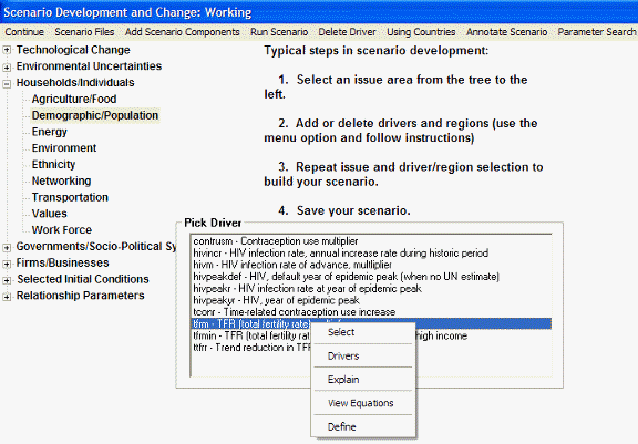International Futures Help System
Exploring and Changing Parameters in IFs
One of the key features of Quick Scenario Analysis with Tree is the ability to change specific variables and parameters.
The image below shows you what menu becomes available to you if you click on one specific parameter from the tree located on the left of the Main Menu of Quick Scenario Analysis with Tree. You are presented with five options: 1.) select the parameter in order to change it; 2.) click on drivers in order to see what variables are affecting what; 3.) click on explain to see a causal diagram and an explanation of what affects this parameter;4.) click on view equations to see the mathematical equations that are used to determine this number or; 5.) click on define to see a brief definition of what the parameter is.

Spend as much time as you would like exploring the drivers, equations, definitions and explanations of various parameters. For this exercise, select TFRM. You will be asked to select a country or group. You can toggle between countries and groups at the top of your program window. For this exercise, choose France.
Because you selected a multiplier, the base-case value is always "1"—the model uses multipliers to easily raise or lower base-case values of many variables, and the multipliers are always "1" in the base case, so that values are unchanged by them. A multiplier can be distinguished from a variable because the ending of most multiplier abbreviations is the letter "m". You could use the Fully Customize option to create any pattern of intervention over time you desire, and at some point you should explore its use. But for now select the High option above the graph and note the change in the figure. This option will phase in a higher fertility for France.
You may also want to more specifically customize the TFRM. This can be accomplished by changing the speed in which your increase or decrease in TFRM takes place (through the slide-down menu on the top right, "Shift Years:"). If you would like more control over your parameters, you can click on the Fully Customize button located below the graph. This will present you with a menu. This will allow you to very specifically change your parameters. Click on the Next Year or Previous Year options to see the numeric representation of how your parameter is being altered from the base-case. You can then choose what year you would like to specifically change, toggle to that year, change the value of that year by clicking on the box next to Desired Value. After you have entered your value, click on the Change/Repeat button to enter it into IFs. This change can then be interpolated for your remaining years by clicking on the Interpolate button. To apply your changes to IFs, click on Exit to Scenario Tree.
Multipliers, however, are not the only form of parameter in IFs. If you select a parameter located under the Selected Initial Conditions category, as the name suggests, you will be able to change initial conditions for certain parameters. For example, the HIV infection rate, initial percentage sub-sub-category (Selected Initial Conditions, Demographic – Mortality) will let you numerically alter the initial percentage of the population infected with HIV for your country or group.
If you choose other parameters, for example, the Carbon Tax (Governments/Socio-Political Systems, Environment), you will be presented with a parameter that numerically begins at zero. This is because there currently is no carbon tax in place. You may change the parameter to take into consideration a future world where carbon taxes are a reality.
Finally, if you choose a parameter in the Relationship Parameters category, you will be able to change the relationship between two different parameters. You may want to change the mathematical relationships in the "black-box".
If you have mistakenly changed a parameter and you would like to remove your alteration, simply click on the parameter change you would like to remove and then click on the Delete Selection option at the top of the menu. You will be asked whether you would really like to delete your parameter change. Click Yes.
Now you have changed a parameter, but it will affect nothing else until you run the model and recalculate all of the variables in it for all of the countries. You have created a Scenario-Load-File (.sce) and, in order to use it more broadly, you need a Run-Result-File (.run). Click on the Run Scenario option from the menu. Your parameter will first be loaded into the working file. You will then be shown the Running Scenario form. You can change the end year or leave it as is. Click on Start Run for IFs to create a new run-file based on your specifications.
After IFs has recomputed the model with your new parameters and saved it as a .run file, you will be presented with a screen that says, "Run Successful – Click to Continue." The run-file labeled "Working File" is now essentially your personalized scenario. Use the techniques you learned in the last section to compare the working file with the base case. But your intervention will have changed much else. Look, for instance, at Gross Domestic Product (GDP) of your country before and after the intervention and at GDP per capita (GDPPC). If your country or grouping was fairly large, you will see changes in many variables elsewhere around the world.
Now return to the Scenario Tree form and select the Scenario Files option, Name and Save sub-option. Give your scenario a name and the parameter intervention (but not the full results after your run) can be saved for you when you return to IFs later. If you are using the stand-alone (non-Web) version of IFs, the Scenario Analysis/File Management/Save option sequence also allows you to save all the computed results of the model run.
 International Futures at the Pardee Center
International Futures at the Pardee Center